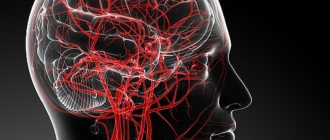Synonyms:
- encephalopathy,
- chronic cerebral ischemia,
- slowly progressive cerebrovascular accident,
- chronic ischemic brain disease,
- cerebrovascular insufficiency,
- vascular encephalopathy,
- atherosclerotic encephalopathy,
- hypertensive encephalopathy,
- atherosclerotic angioencephalopathy,
- vascular (atherosclerotic) parkinsonism,
- vascular (late) epilepsy,
- vascular dementia.
The most widely used term in domestic neurological practice is “dyscirculatory encephalopathy ,” which retains its meaning to this day.
Cerebrovascular insufficiency in the vertebrobasilar region
One of the common causes of dizziness is cerebral circulatory insufficiency in the vertebrobasilar circulation (VBB), which can occur in the form of chronic ischemia, transient cerebrovascular accidents or strokes.
Pathogenesis
The main causes of ischemic changes in this pathology are factors that limit blood flow into the vertebrobasilar system or promote excessive outflow from it to other vascular beds. The pathogenesis of cerebrovascular insufficiency in VBD can cover an extremely wide range of changes. Along with the pathology of the vessels of the vertebrobasilar system (stenosis and occlusion) due to atherosclerosis, extravasal factors are of great importance. For example, thrombosis of the vertebral artery is possible due to dissection of the artery due to whiplash or other neck injury, or inadequate manual manipulation of the cervical spine.
| Kimmerly Anomaly |
Other causes also include pathological tortuosity, congenital developmental disorders in the form of hypo- and aplasia of the vertebral artery, and Kimmerli's anomaly. If the latter is present, when turning the head, bending and compression of the vertebral artery occurs with its possible trauma.
Also, pathological conditions such as Klippel-Feil-Sprengel anomaly, nonfusion of the posterior arch of the atlas, saddle-shaped hyperplasia of the lateral masses of the atlas, underdevelopment of the articular processes of the cervical vertebrae, cervical ribs, “steal” syndrome ( subclavian-vertebral steal) and a number of others. In addition, blockage of blood vessels often occurs with a thrombus that has formed and migrated to the vertebral or basilar artery from the heart cavity.
It should be noted, however, that most of the listed factors are significant specifically for acute vascular catastrophe, manifested by dizziness - transient cerebrovascular accidents or strokes. Systemic dizziness (i.e., when a person has a feeling of falling, moving in space, which is accompanied by nausea and vomiting) with chronic cerebrovascular insufficiency never occurs, and non-systemic dizziness most often disguises anxiety, depression, orthostatic hypotension, metabolic disorders ( hypo-, hyperglycemia), drug dizziness, disturbances of attention, vision, etc., which require adequate diagnosis and treatment.
Clinical manifestations
The core of the clinical picture in transient disorders of cerebral circulation in the vertebrobasilar system are episodes of dizziness, often accompanied by nausea, vomiting, instability when walking and standing, noise, a feeling of fullness in the ears, autonomic disorders in the form of profuse sweating, tachycardia, pallor or, conversely, redness facial skin, lasting from several minutes to several hours. Hearing impairments (mostly decreased) and vision may also be observed (“spots” in front of the eyes, “blurred vision”, “blurred picture”). Extremely dramatic for patients are sudden falls without loss of consciousness (“drop attacks”, Unterharnscheidt syndrome), which are acute circulatory disorders in the reticular formation of the brain stem and usually occur with sudden turns or throwing back the head.
Strokes in the vertebrobasilar region are characterized by a rapid onset (no more than 5 minutes pass from the appearance of the first symptoms to their maximum development, usually less than 2 minutes), as well as the following neurological symptoms:
- motor disorders: weakness, clumsiness of movements or paralysis of the limbs;
- Sensory disorders: loss of sensation or paresthesia of the limbs and face;
- visual impairment in the form of double vision, loss of visual fields;
- imbalance, instability
- impaired swallowing and speech clarity.
A special form of acute cerebrovascular accident in the VBB is a “bowhunter’s stroke”, associated with mechanical compression of the vertebral artery at the level of the cervical spine with extreme rotation of the head to the side.
Mechanical compression of the vertebral artery at the level of the cervical spine, which underlies the development of “archer” stroke.
The mechanism of development of such a stroke is explained by the tension of the artery when turning the head, accompanied by tearing of the intima of the vessel (dissection), especially in patients with pathological changes in the arteries.
Diagnostics
When diagnosing cerebrovascular insufficiency in the VBD, it is necessary to take into account that the symptoms of the disease are often nonspecific and may be the result of another neurological or other pathology, which requires careful collection of patient complaints, study of the medical history, physical and instrumental examinations to identify the main cause of its development. The leading role in the diagnosis of clinically significant changes in blood flow in the vertebrobasilar region is currently played by neuroimaging methods of studying the brain (MRI and CT), as well as Doppler ultrasound and duplex scanning with color flow, which allow non-invasive and relatively cheap assessment of the structure and patency of the vascular bed.
It is important to note that the differential diagnosis between vertigo caused by damage to the cerebellum and/or brain stem (central) and that arising from dysfunction of the vestibular apparatus or vestibular nerve (peripheral) is not always simple. On the one hand, very often such conditions as benign paroxysmal positional vertigo are mistaken for a stroke, at the same time, sometimes patients with acute vascular insufficiency in the VBB are mistakenly treated for “cervical osteochondrosis with vestibulopathic syndrome” by chiropractors and osteopaths with the development of corresponding complications .
Treatment
In the case of an acute neurological deficit (alternating syndromes, cerebellar insufficiency, “negative” scotomas, etc.), the patient should be urgently hospitalized in a regional vascular center or neurological department to exclude a stroke in the VBB. If it is confirmed, treatment is carried out in accordance with currently relevant guidelines and recommendations.
For dizziness due to chronic cerebral circulatory failure, the VBB focuses on drugs that improve cerebral circulation due to vasodilating and rheopositive effects (vinpocetine, cinnarizine, betahistine, etc.). Adequate correction of blood pressure and prevention of thrombus formation in various heart rhythm disorders are of great importance.
← Back
Causes of chronic cerebrovascular insufficiency:
Basic:
- atherosclerosis;
- arterial hypertension.
Additional:
- heart disease with signs of chronic circulatory failure;
- heart rhythm disturbances;
- vascular abnormalities, hereditary angiopathy;
- venous pathology;
- vascular compression;
- arterial hypotension;
- cerebral amyloidosis;
- diabetes;
- vasculitis;
- blood diseases.
For adequate brain function, a high level of blood supply is required. The brain, whose mass is 2.0-2.5% of body weight, consumes 20% of the blood circulating in the body. The value of cerebral blood flow in the hemispheres is 50 ml per 100 grams per minute, glucose consumption is 30 µmol per 100 grams per minute, and in gray matter these values are 3-4 times higher than in white matter. Under resting conditions, the brain's oxygen consumption is 4 ml per 100 grams per minute, which corresponds to 20% of the total oxygen entering the body. With age and in the presence of pathological changes, the amount of cerebral blood flow decreases, which plays a decisive role in the development and increase of chronic cerebral circulatory failure.
The presence of headaches, dizziness, memory loss, sleep disturbances, the appearance of noise in the head, ringing in the ears, blurred vision, general weakness, increased fatigue, decreased performance and emotional lability - these symptoms most often simply “inform” a person about fatigue. Only when the vascular genesis of the “asthenic syndrome” is confirmed and focal neurological symptoms are identified, a diagnosis of “dyscirculatory encephalopathy” is made.
The basis of the clinical picture of discirculatory encephalopathy is currently recognized as cognitive impairment . In case of chronic cerebrovascular accident, it should be noted that there is an inverse relationship between the presence of complaints, especially those reflecting the ability to cognitive activity (memory, attention), and the severity of chronic failure: the more cognitive functions suffer, the fewer complaints. In parallel, emotional disorders develop (emotional lability, inertia, lack of emotional response, loss of interests), various “motor disorders” (disorders of walking and balance).
Diagnosis and treatment of chronic cerebrovascular insufficiency
The article identifies the most common causes of vascular cognitive impairment and their characteristic manifestations. It is noted that vascular cognitive impairment is often combined with emotional disorders. Methods for diagnosis, treatment and prevention of vascular cognitive impairment are discussed. Using choline alfoscerate as an example, the possibility of using drugs with neurometabolic action in chronic cerebrovascular insufficiency is considered.
Rice. 1. The mechanism of formation of symptoms of dyscirculatory encephalopathy
Rice. 2. Montreal Cognitive Function Rating Scale. Test sheet
Table 1. Indicators of cognitive functions in 23 patients with dyscirculatory encephalopathy during treatment with Cereton (M ± m, points)
Rice. 3. Dynamics of the main clinical indicators during treatment according to the Brief Mental Status Scale (MSMS) and the Visual Analog Scale (VAS)
Rice. 4. Evaluation of treatment results by the patient and the doctor
Rice. 5. Indicators of the level of anxiety and depression according to the hospital anxiety and depression scale in patients at the start and end of treatment with Cereton
Table 2. Dynamics of the studied indicators during the treatment (M ± m, points)
Rice. 6. Indicators of quality of life in patients at the start and end of treatment with Cereton according to the SF-36 questionnaire
Introduction
Currently, the appeal of patients with vascular diseases of the brain, including stroke and chronic insufficiency of blood supply to the brain, is an extremely pressing problem not only for neurologists, but also cardiologists, therapists and doctors of other specialties.
Chronic cerebral vascular insufficiency is one of the main causes of the development of cognitive impairment and dementia, as well as disability in old age. It is generally accepted that the cardinal clinical sign of chronic vascular brain damage is vascular cognitive impairment. Vascular cognitive impairments are impairments of cognitive functions of varying severity, which are formed as a result of stroke and/or long-term chronic cerebral circulatory failure. The structure of vascular cognitive impairment includes mild and moderate cognitive impairment, vascular dementia, which is the second most common cause of acquired dementia (after Alzheimer's disease).
In domestic neurological practice, the syndrome of chronic vascular progressive brain damage is designated by various terms: discirculatory encephalopathy, chronic cerebral ischemia, etc. Typically, discirculatory encephalopathy of the first stage corresponds to mild cognitive impairment, discirculatory encephalopathy of the second stage corresponds to moderate cognitive impairment, discirculatory encephalopathy of the third stage corresponds to vascular dementia. .
Etiology and pathogenesis
The most common causes of vascular cognitive impairment are cerebral atherosclerosis, arterial hypertension, diseases of the cardiovascular system with a high risk of embolism in the brain (for example, atrial fibrillation, heart valve pathology, coronary heart disease), diabetes mellitus.
Due to some anatomical and physiological characteristics of the cerebral circulation, there are parts of the brain that are more and less vulnerable to ischemic damage. Physiologically, the deepest structures are in the most unfavorable position: the subcortical gray nodes and the periventricular white matter of the cerebral hemispheres. According to statistics, it is here that focal and diffuse changes in the brain substance associated with ischemic damage are formed earlier and most often [1–4].
The deep sections of the cerebral white matter are located on the border of the carotid and vertebral-basilar basins (watershed zone), and therefore suffer when the main arteries of the head are damaged, for example as a result of atherosclerosis. Microangiopathy of penetrating arteries due to long-term uncontrolled arterial hypertension, diabetes mellitus or other diseases affecting small-caliber vessels also leads to damage to the above departments. Thus, the consequence of damage to both large and small vessels can be damage to the subcortical structures and deep parts of the white matter of the brain. As a result, the phenomenon of disconnection is formed - a disruption of communication between the cortical and subcortical parts of the brain. The phenomenon of disconnection determines the main clinical manifestations of dyscirculatory encephalopathy, which are primarily based on dysfunction of the frontal lobes of the brain. This is due to the special psychophysiological role of the frontal lobes, which plan and control cognitive activity and voluntary behavior. Disruption of communication with other cerebral structures significantly complicates the implementation of this function (Fig. 1) [2, 5–7].
Clinical picture
A sign of vascular cognitive impairment is considered to be a decrease in cognitive function that goes beyond the age norm due to cerebrovascular disease. In this case, it is necessary to ensure that there is a cause-and-effect relationship between cognitive disorders and vascular damage to the brain. Despite the highly variable clinical picture, vascular cognitive impairment in the vast majority of cases is represented by a violation of the so-called executive functions of the brain (planning, control) in combination with visuospatial and soft mnestic disorders. Typically, vascular cognitive impairment is combined with changes in the emotional and behavioral sphere in the form of a decrease in mood, affect lability, and depression [8–10].
At the stage of mild cognitive impairment, the pace of cognitive activity decreases, concentration deteriorates, episodic forgetfulness and increased fatigue during mental stress occur. To diagnose mild cognitive impairment, a detailed neuropsychological examination is necessary. Simple screening techniques, such as the Mini-Mental State Examination, the Clock Drawing Test, and the Frontal Test Battery, as a rule, do not detect disorders [11, 12].
Moderate cognitive impairment is indicated by its more persistent and definite nature. At the same time, impairments in memory and other cognitive functions clearly go beyond the age norm, but do not deprive the patient of independence in everyday life, that is, they do not reach the severity of dementia [8, 9, 10]. The most typical disorders are the planning and control of cognitive activity and behavior, as well as the ability to generalize and draw conclusions. These disorders reflect dysfunction of the anterior parts of the brain. In typical cases, memory suffers mildly in the form of difficulties in reproducing information while the ability to memorize is intact. Memory of life events remains largely intact. In the absence of strokes, speech disorders (aphasia) are not common [1, 6, 8–10, 13–15].
Vascular dementia, an extreme manifestation of vascular cognitive failure, usually develops many years after the onset of the pathological process. The transformation of mild cognitive impairment into dementia is indicated by the patient's dependence on outside help due to cognitive impairment. The presence of such a dependence is evidenced, in particular, by the impossibility or significant difficulties of independent interaction between the patient and the doctor, when the patient cannot accurately tell the history of the disease, does not follow the doctor’s recommendations due to forgetfulness or other cognitive disorders [10, 16].
As mentioned above, before the formation of vascular dementia, and often at the stage of mild dementia, the presence of cognitive impairment may not be obvious during routine collection of complaints and anamnesis. To objectify cognitive status when working with elderly patients with arterial hypertension, cerebral atherosclerosis and other vascular diseases, neuropsychological techniques should be used. The simplest screening technique is the Mini-Cog test, which is a three-word memorization test combined with a clock drawing test [17]. It should be noted that this technique is not very informative for mild and moderate cognitive disorders. For a more accurate assessment of the cognitive status in these cases, the Montreal Cognitive Assessment is currently being actively positioned, which contains tests for executive functions of the brain (number-letter connection test, choice reaction), memory, orientation, drawing geometric figures, etc. (Fig. 2).
Emotional disturbances
Quite often, vascular cognitive impairment is combined with emotional disorders in the form of vascular depression, emotional lability, decreased motivation and apathy. Depression in vascular cognitive impairment is organic in nature and is associated with functional isolation of the frontal lobes of the brain due to the phenomenon of disconnection (see above). Patients themselves rarely complain of depression or decreased mood. The most characteristic symptom is a painful fixation on unpleasant somatic sensations that cannot be fully explained by existing diseases. Typical complaints are headaches, pain in the back, joints, internal organs, dizziness, noise and ringing in the head. Vascular depression is characterized by a protracted course and responds poorly to antidepressant therapy [6, 11, 16].
Another characteristic type of vascular emotional disorders is emotional lability, which is a rapid change in mood and a tendency to explosive reactions. There are episodes of uncontrollable crying that occur for minor reasons, irritability and aggressiveness towards others [6, 11, 16].
Patients with established vascular dementia syndrome often experience an emotional disorder such as apathy. It is manifested by a decrease in motivation and independent motivation for any activity. Patients lose interest in their previous hobbies, do nothing most of the time or are engaged in unproductive activities [1, 11].
Diagnostics
To diagnose vascular cognitive impairment, it is necessary to carefully study the medical history, assess the neurological status, and apply neuropsychological and instrumental research methods (primarily neuroimaging). It is important to note that a prerequisite for correct diagnosis is obtaining convincing evidence of a cause-and-effect relationship between neurological and cognitive symptoms and cerebrovascular pathology.
Neuroimaging methods play an important role in examining patients and establishing the vascular nature of symptoms: computed x-ray or, preferably, magnetic resonance imaging of the brain. This research method allows you to visualize the consequences of acute brain disorders and diffuse changes in the white matter (leukoaraiosis). The presence of these changes confirms the vascular nature of brain damage [10, 13, 15].
Treatment
Treatment of patients with chronic cerebrovascular insufficiency should be aimed at preventing stroke and progression of chronic cerebrovascular pathology, and improving cognitive functions. The choice of a specific drug is determined by the severity and nature of the symptoms, the presence of concomitant diseases in the patient, and drug tolerability [18, 19].
To prevent acute cerebrovascular accidents, timely correction of known risk factors for strokes (low physical activity, obesity, smoking, alcohol abuse), treatment of arterial hypertension, coronary heart disease, and diabetes are necessary. Normalization of blood pressure is recognized as one of the most effective areas of stroke prevention. However, caution should be exercised in adjusting blood pressure in patients with severe stenosis or occlusion of at least one extracranial or intracranial cerebral artery. If a hemodynamically significant stenosis of the cerebral arteries is detected, it is advisable to consult with a vascular surgeon to decide on surgical treatment.
For secondary prevention of stroke in patients who have suffered a transient ischemic attack or acute cerebrovascular accident of non-cardioembolic origin, antiplatelet therapy is recommended. These drugs include acetylsalicylic acid at a dose of 75–300 mg/day or clopidogrel at a dose of 75 mg/day.
In cases of acute cardioembolic cerebrovascular accidents, atrial fibrillation, and valvular heart disease, oral anticoagulants are used. Warfarin has long been the drug of choice. This drug is prescribed in a dose of 2.5 to 10 mg/day under the control of the international normalized ratio (it should be in the range from 2 to 3). Currently, new oral anticoagulants that do not require international normalized ratio control (dabigatran, rivaroxaban, apixaban) are also actively used.
To correct dyslipidemia, drugs from the group of statins are prescribed.
For depression in patients with chronic cerebral vascular insufficiency, psychotherapy and the use of antidepressants are indicated. However, you should refrain from prescribing drugs with anticholinergic properties (for example, tricyclic antidepressants), which may have a negative effect on cognitive status. To improve cognitive functions at the stage of vascular dementia, acetylcholinesterase inhibitors (donepizil, galantamine, rivastigmine) and/or the glutamine receptor blocker memantine can be used. Systematic exercises to train memory and attention (cognitive training) also play an important role in maintaining cognitive functions [14, 19, 20].
Neurometabolic drugs are actively used to treat chronic cerebrovascular insufficiency. The drug of choice may be choline alfoscerate (Cereton), which has a high level of evidence, safety and good tolerability. A feature of Cereton therapy is the rapid onset of the effect, both subjectively (during the first week) and objectively (after two to four weeks). At the same time, restoration of cholinergic neurotransmission during the use of Cereton leads not only to a reduction in neurological and cognitive disorders, but also to a decrease in symptoms of anxiety and depression, as well as an increase in the quality of life of patients.
Cereton is a compound containing 40.5% protected choline, which is electrically neutral. The mechanism of action of the drug is based on the fact that when it enters the body under the action of enzymes, it is split into choline and glycerophosphate. The resulting choline is electrically neutral, due to which it penetrates the blood-brain barrier and enters the brain, where it serves as the basis for the formation of acetylcholine. Deficiency of the latter in the brain has pathogenetic significance in neurodegenerative and vascular diseases, accompanied by a decrease in memory and other cognitive functions. Choline stimulates the synthesis of acetylcholine in the brain, improves the transmission of nerve impulses in cholinergic neurons. Glycerophosphate, being a precursor of neuronal membrane phospholipids, stimulates the formation of phosphatidylcholine, which restores the phospholipid composition of neuronal membranes and improves their plasticity [20, 21].
The clinical efficacy and tolerability of choline alfoscerate in dyscirculatory encephalopathy have been studied in several clinical studies.
L. Parnetti et al. [22] analyzed the results of 13 clinical studies of choline alfoscerate, including double-blind studies, involving a total of 1570 patients with Alzheimer's disease or vascular dementia. During the therapy, a significant improvement in cognitive functions (memory, attention) and emotional state (decreased irritability, emotional lability), and a decrease in the severity of general weakness and dizziness were noted. The study drug was safe and well tolerated in elderly patients.
The effectiveness of choline alfoscerate in post-stroke cognitive impairment was reported in a study by SG Barbagallo et al. [23]. As a result of long-term follow-up, improvements in cognitive function and other indicators of neurological status were shown. A significant improvement in cognitive function was found in 71% of the 2044 patients participating in the study. The drug was also well tolerated and had a low incidence of side effects.
The effectiveness of Cereton in dyscirculatory encephalopathy was studied in the work of L.P. Ponomareva et al. [24]. The study included 23 patients with dyscirculatory encephalopathy of the first and second stages (average age 60 ± 1.2 years) with moderate cognitive impairment. Patients with discirculatory encephalopathy received antihypertensive therapy (n = 20), antiplatelet agents (n = 23), statins (n = 20). Cereton therapy was carried out according to the following regimen: 1000 mg intravenously daily for ten days. Other neurometabolic or vasoactive agents were excluded. As a result, all 23 patients with dyscirculatory encephalopathy showed positive dynamics in their neurological status and cognitive functions (Table 1). Almost all patients noted good tolerability of the drug.
T.N. Batysheva et al. conducted a study to evaluate the effectiveness of Cereton in patients with moderate cognitive disorders of vascular origin [25]. The authors observed 46 patients (19 men and 27 women) aged 39 to 59 years (average 43.8 ± 7.2 years) with moderate cognitive disorders of vascular origin on an outpatient basis. Cereton was administered at a dose of 1000 mg/day intramuscularly for 15 days. The drug was well tolerated, subjective improvement in the patients' condition, and a statistically significant improvement in cognitive function indicators assessed using the Brief Mental Status Assessment Scale (an average increase of 1.5 points) (Table 2, Fig. 3 and 4).
I.D. Stulin et al. presented the results of an open, non-comparative study of the effectiveness of Cereton in 25 patients with dyscirculatory encephalopathy of the first and second stages [26]. All patients were administered Cereton at a dose of 1000 mg/day intravenously for five days, then intramuscularly for another ten days. All patients were assessed for neurological status, severity of cognitive and emotional disorders. Computed or magnetic resonance imaging of the brain, duplex scanning of the brachiocephalic arteries, transcranial Doppler sonography and electroencephalography were performed. As a result of treatment, an improvement in well-being was noted, night sleep was normalized, the level of anxiety decreased, and the severity of focal neurological symptoms decreased. By the third week of treatment, there was a statistically significant improvement in memory scores, a trend towards improvement in attention scores and test performance speed. When electroencephalography was repeated in 14 patients, positive dynamics of bioelectrical activity of the brain was observed in the form of a decrease in the representation of slow waves and an increase in the presence of the alpha rhythm.
There is evidence of the effectiveness of choline alfoscerate in Alzheimer's disease combined with cerebrovascular disease. The ASCOMALVA double-blind, multicenter trial is currently underway. The preliminary results of the study are based on a 12-month follow-up analysis of 91 patients aged 56 to 91 years, mean age 75 ± 10 years. Patients were randomized to treatment with a combination of donepizil and choline alfoscerate or donepizil monotherapy. The dynamics of symptoms were analyzed at the third, sixth, ninth and 12th months of treatment. Cognitive functions, daily activities of the patient and the severity of behavioral disorders were assessed. As a result, it was found that the use of a combination of donepezil and choline alfoscerate has advantages compared to donepizil monotherapy [27].
N.V. Pizova studied the effect of Cereton not only on cognitive functions, but also on indicators of quality of life (a specific questionnaire for assessing the patient’s quality of life - Short Form-36), as well as on the level of anxiety and depression using the Hospital Anxiety and Depression Scale Scale) [28]. To 25 patients with moderate cognitive impairment of vascular etiology, Cereton was prescribed at a dose of 1000 mg in 200 ml of saline for 15 days, and then treatment was continued on an outpatient basis at a dose of 400 mg (one capsule) three times a day for three months. During therapy, a decrease in the severity of cognitive impairment and other neurological symptoms and moderate cognitive impairment was noted: the score on the Mini-Mental State Examination increased from 25.6 to 28.7. Statistically significant decreases in the severity of anxiety and depression and a significant improvement in the quality of life of patients were also noted. Subjectively, the therapeutic effect was determined already in the first week (from the fifth to sixth day), and from the 15th day it was recorded using objective research methods (Fig. 5 and 6).
It is recommended to begin treatment with Cereton with injections of 1000 mg/day for 15 days, then switch to oral administration of one capsule (400 mg) three times a day for six months. This course allows you to achieve reliable and stable clinical results. However, it must be taken into account that discirculatory encephalopathy is a chronic disease with a progressive course, especially in some cases (a combination of discirculatory encephalopathy with arterial hypertension, coronary heart disease, diabetes mellitus). For this reason, to improve the prognosis of vascular cognitive impairment, it can be recommended to repeat injection courses three to four times a year and constantly take Cereton capsules in the interval between injection courses.
Conclusion
Thus, timely diagnosis of the disease and elimination of existing vascular risk factors can significantly improve the prognosis of vascular cognitive impairment, preserving the ability of patients to work for a long time. Treatment of vascular cognitive impairments themselves must begin immediately from the moment they are identified. This will significantly slow down the dynamics of their development and improve the patient’s quality of life.








